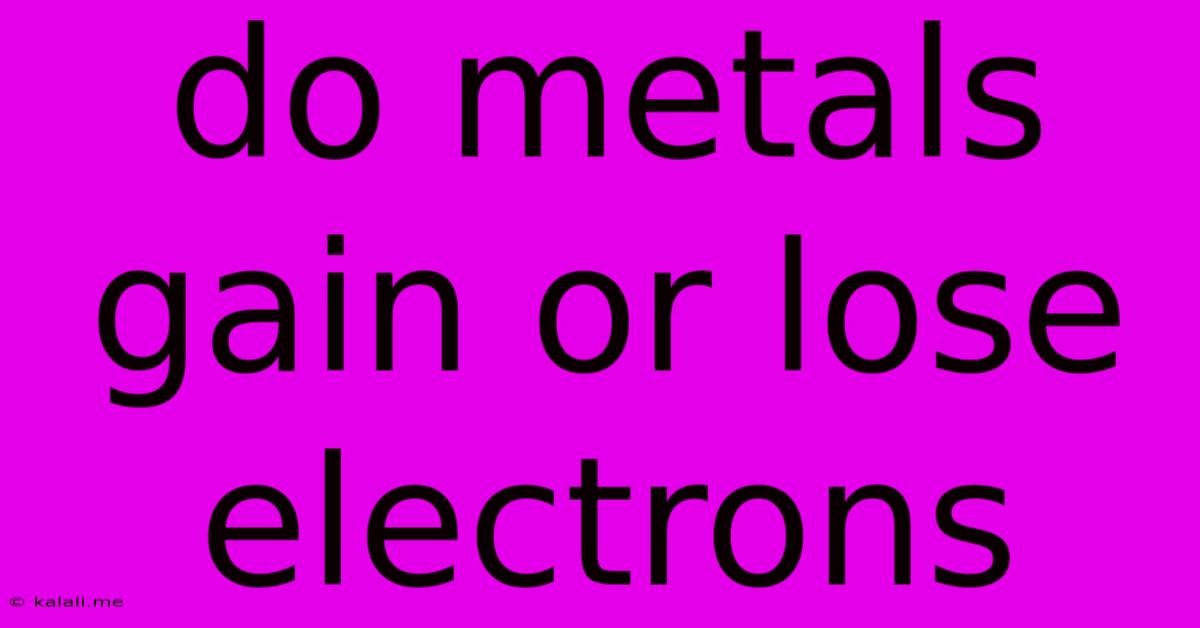Do Metals Gain Or Lose Electrons
Kalali
Jun 05, 2025 · 3 min read

Table of Contents
Do Metals Gain or Lose Electrons? Understanding Metallic Properties
This article explores the fundamental behavior of metals regarding electron transfer, a key concept in chemistry and crucial for understanding their unique properties. We'll delve into the reasons behind this behavior and its implications. Understanding whether metals gain or lose electrons is key to comprehending their reactivity and role in various chemical processes.
Metals are characterized by their tendency to lose electrons, forming positively charged ions known as cations. This is a defining characteristic that distinguishes them from nonmetals, which tend to gain electrons. This electron loss is directly linked to their electronic structure and the relative ease with which they can achieve a stable electron configuration.
The Role of Valence Electrons
The answer lies in the arrangement of electrons in their outermost shell, known as valence electrons. Metals typically have a small number of valence electrons (often 1, 2, or 3). These electrons are relatively loosely held by the positively charged nucleus. Losing these valence electrons allows the metal to achieve a more stable, lower-energy electron configuration, often resembling the electron configuration of a noble gas. This stable configuration is a driving force behind their reactivity.
Ionization Energy and Electronegativity
Two key properties further explain this behavior:
-
Ionization energy: This is the energy required to remove an electron from an atom. Metals generally have low ionization energies, meaning it requires relatively little energy to remove their valence electrons. The lower the ionization energy, the more readily a metal will lose electrons.
-
Electronegativity: This measures an atom's tendency to attract electrons in a chemical bond. Metals have low electronegativity, indicating a weaker pull on electrons compared to nonmetals. This low electronegativity contributes to their willingness to lose electrons rather than gain them.
Examples of Metal Electron Loss
Consider the following examples:
-
Sodium (Na): Sodium has one valence electron. It readily loses this electron to form a Na⁺ ion, achieving a stable electron configuration like Neon (Ne).
-
Magnesium (Mg): Magnesium has two valence electrons. It loses both to form a Mg²⁺ ion, also achieving a stable configuration.
-
Aluminum (Al): Aluminum has three valence electrons and forms Al³⁺ ions by losing all three.
In each case, the metal atom becomes a positively charged ion by losing electrons to achieve a more stable electronic structure.
Consequences of Electron Loss
The loss of electrons by metals has significant consequences, impacting their properties and reactivity:
-
Formation of ionic compounds: Metals readily react with nonmetals, forming ionic compounds. The metal loses electrons to form a cation, and the nonmetal gains electrons to form an anion. The electrostatic attraction between these oppositely charged ions holds the compound together.
-
Conductivity: The ability of metals to conduct electricity and heat is directly related to the mobility of their valence electrons. These delocalized electrons can move freely throughout the metal lattice, facilitating the transfer of charge and energy.
-
Malleability and ductility: The ability of metals to be hammered into sheets (malleability) and drawn into wires (ductility) is also linked to the mobile electrons. The metallic bonding allows metal atoms to slide past each other without disrupting the overall structure.
In conclusion, metals lose electrons to achieve a stable electron configuration. This characteristic is fundamental to understanding their properties, reactivity, and widespread applications in various fields. The loss of electrons leads to the formation of positive ions, contributes to their conductivity, and influences their malleability and ductility.
Latest Posts
Latest Posts
-
Copado How To Deploy An Object Sharing Setting
Jun 06, 2025
-
Wits Not Skin Off Our Back Menaing
Jun 06, 2025
-
I Am Mei Am Melucifer Mornhe Is Mthe God Speede
Jun 06, 2025
-
Does Holding Your Hands Together While Praying Promote The Devil
Jun 06, 2025
-
Gis Pro Move Labels On Topographic Basemap
Jun 06, 2025
Related Post
Thank you for visiting our website which covers about Do Metals Gain Or Lose Electrons . We hope the information provided has been useful to you. Feel free to contact us if you have any questions or need further assistance. See you next time and don't miss to bookmark.